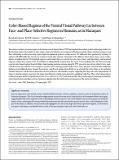Color-Biased Regions of the Ventral Visual Pathway Lie between Face- and Place-Selective Regions in Humans, as in Macaques
Author(s)
Lafer-Sousa, Rosa; Conway, Bevil; Kanwisher, Nancy
DownloadKanwisher_Color-biased.pdf (14.08Mb)
PUBLISHER_CC
Publisher with Creative Commons License
Creative Commons Attribution
Terms of use
Metadata
Show full item recordAbstract
The existence of color-processing regions in the human ventral visual pathway (VVP) has long been known from patient and imaging studies, but their location in the cortex relative to other regions, their selectivity for color compared with other properties (shape and object category), and their relationship to color-processing regions found in nonhuman primates remain unclear. We addressed these questions by scanning 13 subjects with fMRI while they viewed two versions of movie clips (colored, achromatic) of five different object classes (faces, scenes, bodies, objects, scrambled objects). We identified regions in each subject that were selective for color, faces, places, and object shape, and measured responses within these regions to the 10 conditions in independently acquired data. We report two key findings. First, the three previously reported color-biased regions (located within a band running posterior–anterior along the VVP, present in most of our subjects) were sandwiched between face-selective cortex and place-selective cortex, forming parallel bands of face, color, and place selectivity that tracked the fusiform gyrus/collateral sulcus. Second, the posterior color-biased regions showed little or no selectivity for object shape or for particular stimulus categories and showed no interaction of color preference with stimulus category, suggesting that they code color independently of shape or stimulus category; moreover, the shape-biased lateral occipital region showed no significant color bias. These observations mirror results in macaque inferior temporal cortex (Lafer-Sousa and Conway, 2013), and taken together, these results suggest a homology in which the entire tripartite face/color/place system of primates migrated onto the ventral surface in humans over the course of evolution.
Date issued
2016-02Department
Massachusetts Institute of Technology. Department of Brain and Cognitive Sciences; McGovern Institute for Brain Research at MITJournal
Journal of Neuroscience
Publisher
Society for Neuroscience
Citation
Lafer-Sousa, R., B. R. Conway, and N. G. Kanwisher. “Color-Biased Regions of the Ventral Visual Pathway Lie between Face- and Place-Selective Regions in Humans, as in Macaques.” Journal of Neuroscience 36, no. 5 (February 3, 2016): 1682–97.
Version: Final published version
ISSN
0270-6474
1529-2401